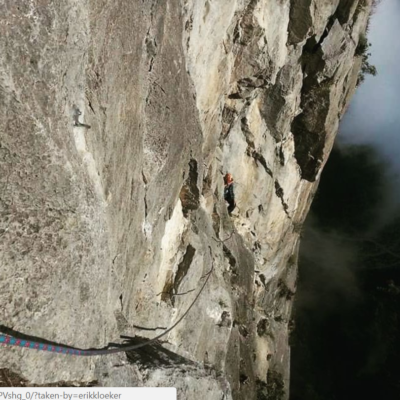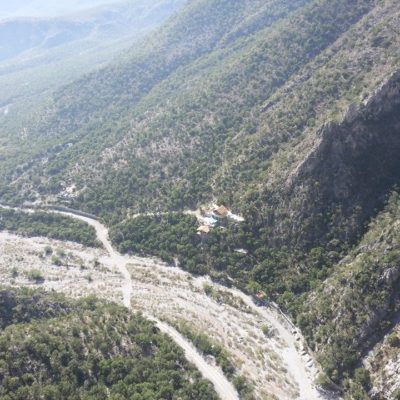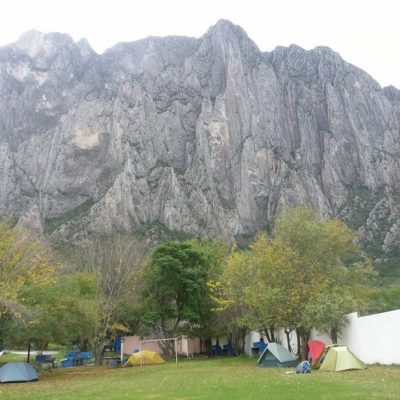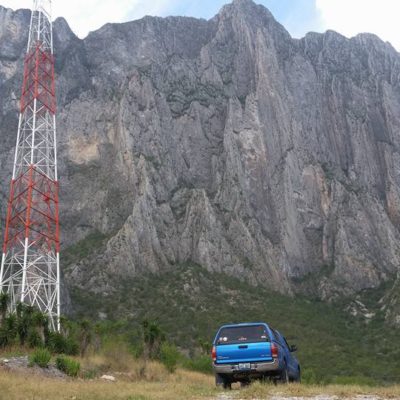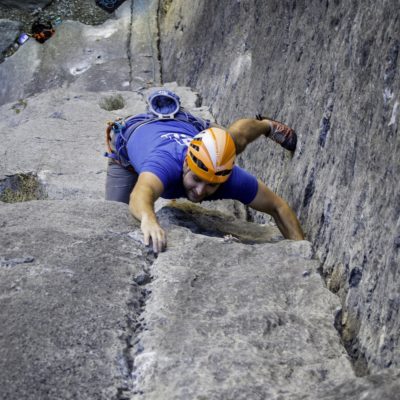About Potrero Chico, Mexico
Potrero Chico is an internationally renowned rock climbing destination in the Mexican state of Nuevo Leon, located an hour outside Mexico’s third largest metropolitan area, Monterrey.
With it’s large limestone ridges, spires, and fins towering up to 2300 feet tall, and bolted multi-pitch sport routes, Potrero Chico is touted as one of the top ten sport climbing destinations in the world. A plethora of moderate multi-pitch routes in the 5.8 to 5.10 range, excellent weather throughout the winter, and inexpensive food and lodging, make it easy to see why the area has became such a popular destination for climbers from the United States and abroad.
Potrero Chico is located adjacent to the small town of Hidalgo, a beautiful and safe city which is home to some of the friendliest people you’ll meet anywhere. Weekly open air markets, quaint living, and a stunning landscape all contribute to the rich culture of the area.
About CPMG:
Climb Potrero Mountain Guides is the premiere climbing guide service for El Potrero Chico, Mexico, all of our guides are certified by the American Mountain Guide Association and have proper Wilderness Medical Training to ensure your experience is a safe and successful one. More about CPMG
Featured Clinic:
Multi-Pitch 101 is our Potrero Chico Crash Course. A 2 day private course designed to prepare you and your partners for climbing the stunning multi-pitch faces in Potrero Chico. This course covers everything from anchor building and belay systems, to rappelling and basic self rescue. All of our courses have an emphasis on safety and efficiency to make sure your trip to Potrero is a happy and successful one. More Info on Multi-Pitch Crash Course
Prices:
1 Person $375
2 Person $500
Ask about options for larger groups!
To Simul-Rappel or Not in El Potrero Chico and Elsewhere

Disclaimer: Simul-Rappelling is a technically advanced technique, which even when done perfectly can add additional risks as compared to traditional rappelling.
What is Simul-Rappelling?
Short for simultaneous rappelling, is a technique where two climbers descend one rope, each climber descending on a single strand on either side of the rope.
How can you minimize the risks when choosing to simul-rappel?
So what are the risks, are they worth it?
The descent can be the most dangerous part of anyone’s climbing day, long routes involve pitch after pitch of monotonous maneuvers, a repetitiveness than can open even the most experienced climbers up to the risk of making simple mistakes. Consider the descent takes place when you are often the most tired, dehydrated, and otherwise mentally drained than any other part of the day. Complacency Kills.
Perhaps nowhere else in the world is the simul-rappelling technique more popular than in the sport climbing paradise of El Potrero Chico. Relatively straight forward, and primarily single rope length rappels,combined with long bolted limestone multi-pitches, lend them self to simul-rappelling in ways that some other areas do not, so are the added risks worth the time savings?
Advantages of Simul-Rappelling
- You don’t need to use an ATC (tube style belay/rappel device) so you can ditch the autoblock rappel backup in favor of using an assisted locking device such as the gri-gri a single line device which would normally necessitate a biner block/Reepschnur setup to rappel with. Of course one should still use a backup if they choose to simul with an ATC. Additionally, I typically still bring my ATC and a friction hitch to keep my descent options open.
- Simul-Rappelling can be faster, (obviously!) this is the main appeal, the degree to which it is faster is heavily debated. A slow simul-rappelling party will be beat by an efficient party who is rappelling traditionally anytime. Realize that if you are already slow at rappelling, more time can be made up by increasing your efficiency than by switching to simuling. Nevertheless, one can’t argue otherwise, rappelling at the same time as your partner can speed things up.
- Communication with your partner remains excellent as you can stay close to each other throughout the rappel.
- Rockfall risk can be somewhat minimized. If you and your partner are right next to each other, there is less likelihood of the second rappeler knocking stuff down on the first rappeler as can happen in traditional rappelling. More practically, minimize rockfall risk by avoiding routes with multiple parties already on them as much as possible.
- Finding the path of descent and next set of anchors can be easier, especially in the dark. Two headlamps, two sets of eyes, two brains.
Disadvantages of Simul-Rappelling
- Every danger encountered in normal rappelling is now multiplied by 2. You are literally counterbalanced against the weight of your partner, if they fall you fall and vica versa. If one climber rappels off the end of their rope, an accident which would normally only claim one victim, is now likely to claim both.
- You are at the mercy of your climbing partner, only choose partners you have complete trust in and have practiced the techniques with.
- A cut rope results in system failure for both climbers.
- In the event of passing up an anchor station, self rescue may become more complicated. On the flip side of this, with both rappellers on gri-gri’s ascending can be more straightforward.
Safety Tips when choosing to Simul-Rap
- Use an assisted braking device such as the Petzl gri gri, it is more fool proof and less time to set up than an extended ATC and an autoblock hitch. The gri-gri is also easier to suck in slack to weight the rappel before departing.
- Which brings up the next point, ALWAYS ensure both people are weighted on their respective lines and conduct a safety check before disconnecting any Personal Anchor Tether.
- TIE KNOTS. Stopper Knots. In the end of both ropes. Nothing more needs to be said about this, this isn’t the alpine folks, a stuck rope doesn’t mean freezing to death. Failure to close the system is one of the most common causes of accidents in climbing, and now it’s not just your butt on the line, it’s your partner’s too. Unless your one of the few willing to accept additional risks for the sake of a speed ascent, a few extra seconds to pull up and knot the rope is not going to make or break your day. The stopper knot should be a well dressed double or triple fisherman’s knot or a figure eight or overhand on a bight clipped to your belay loop. I often prefer clipping the end of the rope to myself in this manner because it decreases the likelihood of getting your rope stuck in cactus and other features as it is blown around by the wind and is more polite to parties below than throwing the end down. It also closes the system in a way that is independent of the belay device/gri-gri.
- Don’t rap faster than your partner, it’s reasonable to spread out a few feet so you’re not knocking into one another, but don’t rappel a far distance away from your partner, communication can be diminished and complacency can creep in as you can forget your simul-rappelling when you reach a ledge or belay anchor.
- Never unweight your rope with your partner still on rappel, in fact don’t unweight the rope ever until you and your partner are both clipped in at the anchor. If the reasons for this aren’t obvious, you need not be simul-rapping!
- Choose Simul-Rappelling partners who closely match your own weight, when dealing with weight imbalances use a biner block technique to fix the side of the rope which the heavier climber will descend on. Failure to do so can cause the rope to slide through the anchor.
- This technique should be avoided on rappels where the rope running over sharp edges pose a risk of cutting or damaging the rope.
How to Speed Things up without Simul-Rapping
- Begin feeding the next rappel as soon as you get to the anchor station, don’t wait for your partner to be at the anchor with you.
- Stack your rappels, this works best when using an extended rappel device, simply load both you and your partner’s ATC before the first rappeler starts down. In this way the second rappeler can start immediately when the first rappeler unweights the rope. This technique has the added advantage of being able to double check each others setup, and is especially recommended for less experienced rappellers.
Final Thoughts: Of the 3 fatal rappelling accidents that have occurred in the recent history of Potrero Chico, 1 accident occurred while the party was simul-rappelling and two have occurred with parties using traditional rappelling techniques. Regardless of which technique was used, the commonality is that in all 3 cases, each party failed to close the system by knotting both ends of the rope.
I hope this article helps the reader weigh the pros and cons of different techniques in a way that allows one form their own educated opinion. Choose the right technique for the given situation and your abilities. In whichever technique you choose remember this: Slow is smooth and smooth is fast. Be efficient, do your safety checks, and tie knots.
Related Articles:
https://rockandice.com/climbing-news/brad-gobright-dies-in-accident-in-el-potrero-chico-mexico/
https://www.outsideonline.com/2406215/brad-gobright-climber-dies


